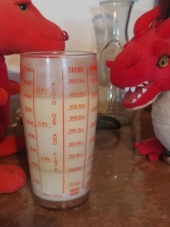

 7
7




Failure is a sign of activity and learning. It had nothing to do with under achievement
I never want to have a team member who has never failed - They are not doing!! 👍
 9
9




A human being should be able to change a diaper, plan an invasion, butcher a hog, conn a ship, design a building, write a sonnet, balance accounts, build a wall, set a bone, comfort the dying, take orders, give orders, cooperate, act alone, solve equations, analyze a new problem, pitch manure, program a computer, cook a tasty meal, fight efficiently, die gallantly. Specialization is for insects.
-Robert A. Heinlein

 5
5




Some places need to be wild
 6
6




Paul Fookes wrote:There is a lot of conjecture about augmenting a vehicles fuel with a hydrogen fuel cell. I sourced the component parts and installed one in my 2013 Nissan X-Trail. Since installing the unit it appears to me that it is effective in increasing the number of Kilometers achieved on one tank of fuel. The gauge shows 7.8 litres/ 100 Km but with the hydrogen is shows 6.8litres/ 100 Km. so I am effectively getting an extra 150 Km per tank. The Fuel cell is now out to check and the consumption has increased back to 7.8. Does it work? For me, yes.
Has anyone else had experience with a hydrogen fuel cell? what was/ is your experience?












 5
5




David Baillie wrote:
Paul Fookes wrote:There is a lot of conjecture about augmenting a vehicles fuel with a hydrogen fuel cell. I sourced the component parts and installed one in my 2013 Nissan X-Trail. Since installing the unit it appears to me that it is effective in increasing the number of Kilometers achieved on one tank of fuel. The gauge shows 7.8 litres/ 100 Km but with the hydrogen is shows 6.8litres/ 100 Km. so I am effectively getting an extra 150 Km per tank. The Fuel cell is now out to check and the consumption has increased back to 7.8. Does it work? For me, yes.
Has anyone else had experience with a hydrogen fuel cell? what was/ is your experience?
As mentioned above it's not really a fuel cell. Usually its referred to as brown gas where the hydrogen and oxygen are mixed as formed and delivered together. If you have an older engine or even some throttle body fuel injected engines you could see some improved mileage in the short run. In a newer computer controlled engine with multi port injection nothing. If you are using your alternator to generate the brown gas you will suffer early alternator death due to overheating. If you push the amount of hydrogen too high you will suffer metal fatigue in your engine and premature death. So yes reduced fuel consumption maybe on older vehicles but increased component wear and possible catastrophic failure... No mention of the incredible possible explosion risk of delivering hydrogen and oxygen through a single line...
Failure is a sign of activity and learning. It had nothing to do with under achievement
I never want to have a team member who has never failed - They are not doing!! 👍
 7
7
















 5
5




Douglas Alpenstock wrote:Paul, that's interesting. You just mentioned this is a diesel -- I suspect that changes the calculations entirely.
Failure is a sign of activity and learning. It had nothing to do with under achievement
I never want to have a team member who has never failed - They are not doing!! 👍










 3
3




Some places need to be wild












 3
3




Eric Hanson wrote:Thanks for clarifying for me that this is not a fuel cell as I had initially thought. I was initially thinking of a fuel cell replacing a battery pack in some sort of hybrid configuration.
So as you describe, would the vehicle need periodic hydrogen refueling. On a slightly different note, you mentioned using natural gas as a hydrogen substitute.
Eric
Failure is a sign of activity and learning. It had nothing to do with under achievement
I never want to have a team member who has never failed - They are not doing!! 👍










 2
2




Some places need to be wild










 5
5




Some places need to be wild












 4
4




Eric Hanson wrote:Paul,I would think that if one operated regularly in cold weather, that alone might be worth the money.
Interesting concept, and I generally like your idea “if you can conceive it, it can be built.” I don’t suppose you know what type of battery your friend used to build his electric car back in the ‘80s do you?
Eric
Failure is a sign of activity and learning. It had nothing to do with under achievement
I never want to have a team member who has never failed - They are not doing!! 👍










 4
4




Some places need to be wild

















|
this tiny ad is trying to guide you away from the dark side!
The new gardening playing cards kickstarter is now live!
https://www.kickstarter.com/projects/paulwheaton/garden-cards
|



